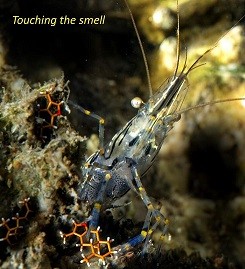
PNAS: Una forma tattile di olfatto – doi: 10.1073/pnas.1614655114
Di Fabiana Alfieri In Non categorizzato Il 12 Aprile 2017
Il Dipartimento di Biologia Federiciano, nelle persone del prof. Gianluca Polese e della dott.ssa Laura Magliozzi, ha contribuito alla realizzazione di un eccellente lavoro capitanato dall’ICB di Pozzuoli e recentemente pubblicato sulla prestigiosa rivista PNAS che mette in crisi la tradizionale distinzione tra olfatto e gusto basata su criteri spaziali.
http://www.unina.it/-/14071312-una-forma-tattile-di-olfatto-
Una forma tattile di olfatto
Recenti studi sui meccanismi di comunicazione chimica in ambiente acquatico mettono in crisi la tradizionale distinzione tra i sensi chimici (olfatto e gusto) basata su criteri spaziali.
L’olfatto è tradizionalmente considerato un senso “a distanza”, mentre il gusto è generalmente trattato come un senso “per contatto”. Tale distinzione paradigmatica, basata su criteri spaziali, e sulla quale si fonda gran parte della attuale letteratura su anatomia, fisiologia e genetica dell’olfatto, è stata messa in discussione in un articolo di prospettiva già pubblicato nel 2014 sul giornale Frontiers in Chemistry.1 Secondo tale nuova prospettiva, passando dall’ambiente aereo a quello acquatico può osservarsi una inversione nella portata a distanza dell’olfatto, in particolare quando i segnali olfattivi sono volatili ma insolubili in acqua. Questa nuova visione anticipava e creava le premesse per il recente riscontro empirico pubblicato in marzo 2017 nei Proceedings of the National Academy of Sciences of the United States of America (PNAS),2 il quale sfida l’attuale letteratura sulla chemiorecezione in ambiente acquatico, secondo cui il mondo olfattivo di crostacei e pesci è limitato alla sola percezione a distanza di sostanze solubili in acqua. Composti noti per contribuire all’odore di piante terrestri come la curcuma e la mirra, sono stati isolati anche in animali acquatici che li utilizzano come armi chimiche difensive. La ricerca mostra che un comune gamberetto (Palaemon elegans) e il pesce zebra (Danio rerio) possono percepire l’odore di tali sostanze volatili e insolubili in acqua, ma solo dopo averle toccate. Si dimostra, inoltre, che l’apprendimento evitativo gioca un ruolo fondamentale nella discriminazione tattile degli odori difensivi.
1. Sensing marine biomolecules: smell, taste, and the evolutionary transition from aquatic to terrestrial life. Frontiers in Chemistry 2014, doi: 10.3389/fchem.2014.00092
2. Volatile secondary metabolites as aposematic olfactory signals and defensive weapons in aquatic environments. Proceedings of the National Academy of Sciences USA 2017;
doi: 10.1073/pnas.1614655114
————————————————————————————————————————————————
A tactile form of olfaction
Recent studies on the mechanisms of chemical communication in aquatic environments undermine the traditional distinction between the chemical senses (olfaction and gustation) based on spatial criteria.
The sense of smell is traditionally considered a “distance sense”, while taste is treated as a “contact sense”. This paradigmatic distinction, which pervades the current literature on the anatomy, physiology, and genetics of olfaction, has been the subject of major logical criticism in a perspective article already published in Frontiers in Chemistry in 2014.1 The new perspective proposed that, moving from the terrestrial to the aquatic environment, a reversal of the spatial range of olfaction can occur when the olfactory signals are biomolecules that combine volatility in air and insolubility in water. This idea anticipated and created the premise for the recent empirical confirmation published in March 2017 in the Proceedings of the National Academy of Sciences of the United States of America (PNAS)2 that challenges the current literature on chemical communication in aquatic environments, which is based on the idea that the olfactory world of crustaceans and fish is limited to the perception of waterborne compounds. Compounds known to contribute to the smell of terrestrial plants such as turmeric and myrrh were also isolated in aquatic animals that use them as defensive chemical weapons. The report shows that both a common shrimp (Palaemon elegans) and the zebrafish (Danio rerio) can sense the smell of such volatile and insoluble compounds, but only after touching them. The paper also shows that avoidance learning plays a key role in the tactile discrimination of defensive odors.
1. Sensing marine biomolecules: smell, taste, and the evolutionary transition from aquatic to terrestrial life. Frontiers in Chemistry 2014, doi: 10.3389/fchem.2014.00092
2. Volatile secondary metabolites as aposematic olfactory signals and defensive weapons in aquatic environments. Proceedings of the National Academy of Sciences USA 2017;
doi: 10.1073/pnas.1614655114
